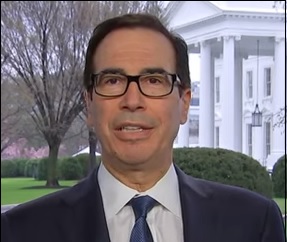By Pam Martens and Russ Martens: November 20, 2020 ~
Yesterday, U.S. Treasury Secretary Steve Mnuchin stunned markets by demanding in a letter to Federal Reserve Chairman Jerome Powell that the Fed return Treasury funds that are backstopping the bulk of its emergency lending programs and wind down these programs by year’s end. Adding further shock, the Fed rebuked the idea with its own statement, saying this:
“The Federal Reserve would prefer that the full suite of emergency facilities established during the coronavirus pandemic continue to serve their important role as a backstop for our still-strained and vulnerable economy.”
At issue in this newly-emerged war between Treasury and the Fed is $454 billion, $340 billion of which has yet to be accounted for. The process has played out as follows:
On March 27, 2020 President Trump signed the CARES Act emergency stimulus plan into law. That law instructed the Treasury Secretary to make $454 billion available to the Federal Reserve for emergency lending facilities. The funds were to make $10 of Fed emergency funding available for each $1 from the taxpayer. The taxpayers’ money was to be used as loss-absorbing capital. The $454 billion would have supported up to $4.54 trillion in lending by the Fed.
But according to the Fed’s H.4.1 balance sheet statements that are released weekly on Thursday afternoon, the Fed has only used the following amounts of money from the Treasury: $10 billion for the Commercial Paper Funding Facility; $37.5 billion for the Corporate Credit Facilities to buy up corporate bonds and Exchange Traded Funds; $37.5 billion for the Main Street Lending Facilities for loans to small and mid-size businesses; $17.5 billion for the Municipal Liquidity Facility that buys up municipal bonds; $10 billion for the Term Asset-Backed Securities Loan Facility; and $1.5 billion for the Money Market Mutual Fund Liquidity Facility which bailed out toxic waste in money market mutual funds to keep them from breaking a buck. All of this adds up to just $114 billion out of the $454 billion that Congress allocated.
Wall Street On Parade has been repeatedly asking for an explanation as to what has happened to the balance of $340 billion that Congress intended to be used to help American families and businesses during the worst economic downturn since the Great Depression. (See As 98,000 Businesses Permanently Closed, the Fed and Treasury Have Sat on $340 Billion of Untapped Money from the CARES Act.)
Not only does the American public not know what happened to that $340 billion but as we pointed out previously “despite regular promises from the Fed Chairman that the Fed will be transparent about its lending programs, there are four programs for which the Fed has yet to provide transaction level data – meaning the names of the borrowers and how much they borrowed. Those programs include: the Primary Dealer Credit Facility; the Commercial Paper Funding Facility; the Money Market Mutual Fund Liquidity Facility; and the Fed’s Repo Loan facility that sluiced over $9 trillion cumulatively to the trading houses on Wall Street beginning on September 17, 2019 – months before the first case of COVID-19 appeared anywhere in the world.”
Three of the programs that the Fed has operated in the dark are the very programs that Mnuchin has asked in his letter to be extended for 90 days: the Primary Dealer Credit Facility; the Commercial Paper Funding Facility and the Money Market Mutual Fund Liquidity Facility. In addition, Mnuchin would like the Fed’s Paycheck Protection Program Liquidity Facility, which provided more than $3 billion to Citigroup, to also be extended for 90 days.
Wall Street On Parade has written more than 100 articles on the Fed’s stealthy lending programs. We’ve created an archive of these articles in the public interest at this link.


